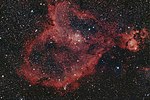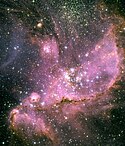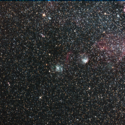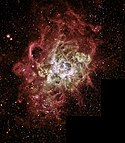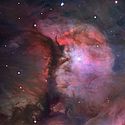Lista över diffusa nebulosor
Detta är en lista över diffusa nebulosor.
Se även
Media som används på denna webbplats
NGC 1579
Författare/Upphovsman: ESO/Igor Chekalin, Licens: CC BY 4.0
This new image of the reflection nebula Messier 78 was captured using the Wide Field Imager camera on the MPG/ESO 2.2-metre telescope at the La Silla Observatory, Chile. This colour picture was created from many monochrome exposures taken through blue, yellow/green and red filters, supplemented by exposures through a filter that isolates light from glowing hydrogen gas. The total exposure times were 9, 9, 17.5 and 15.5 minutes per filter, respectively.
The NASA/ESA Hubble Space Telescope has imaged a violent stellar nursery called NGC 2174, in which stars are born in a first-come-first-served feeding frenzy for survival.
The problem is that star formation is a very inefficient process; most of the ingredients to make stars are wasted as the cloud of gas and dust, or nebula, gradually disperses. In NGC 2174, the rate at which the nebula disperses is further speeded up by the presence of hot young stars, which create high velocity winds that blow the gas outwards.
These fiery youngsters also bombard the surrounding gas with intense radiation, making it glow brightly, creating the brilliant scene captured here. The nebula is mostly composed of hydrogen gas, which is ionised by the ultraviolet radiation emitted by the hot stars, leading to the nebula’s alternative title as an HII region. This picture shows only part of the nebula, where dark dust clouds are strikingly silhouetted against the glowing gas.
NGC 2174 lies about 6400 light-years away in the constellation of Orion (The Hunter). It is not part of the much more familiar Orion Nebula, which lies much closer to us. Despite its prime position in a very familiar constellation this nebula is faint and had to wait until 1877 for its discovery by the French astronomer Jean Marie Edouard Stephan using an 80 cm reflecting telescope at the Observatoire de Marseille.
This picture was created from images from the Wide Field Planetary Camera 2 on Hubble. Images through four different filters were combined to make the view shown here. Images through a filter isolating the glow from ionised oxygen (F502N) were coloured blue and images through a filter showing glowing hydrogen (F656N) are green. Glowing ionised sulphur (F673N) and the view through a near-infrared filter (F814W) are both coloured red. The total exposure times per filter were 2600 s, 2600 s, 2600 s and 1000 s respectively and the field of view is about 1.8 arcminutes across.Författare/Upphovsman: ESA/Hubble & NASA, Licens: CC BY 3.0
The magnificent reflection nebula NGC 2023 lies nearly 1500 light-years from Earth. It is located within the constellation of Orion (The Hunter), in a prestigious area of the sky close to the well-known Flame and Horsehead Nebulae. The entire structure of NGC 2023 is vast, at four light-years across. This NASA/ESA Hubble Space Telescope picture just takes in the southern part, with the subtle shades of colour closely resembling those of a sunset on Earth.
NGC 2023 surrounds a massive young B-type star. These stars are large, bright and blue-white in colour, and have a high surface temperature, being several times hotter than the Sun. The energy emitted from NGC2023’s B-type star illuminates the nebula, resulting in its high surface brightness: good news for astronomers who wish to study it. The star itself lies outside the field of view, at the upper left, and its brilliant light is scattered by Hubble’s optical system, creating the bright flare across the left side of the picture, which is not a real feature of the nebula.
Stars are forming from the material comprising NGC 2023. This Hubble image captures the billowing waves of gas, 5000 times denser than the interstellar medium. The unusual greenish clumps are thought to be Herbig–Haro objects. These peculiar features of star-forming regions are created when gas ejected at hundreds of kilometres per second from newly formed stars impacts the surrounding material. These shockwaves cause the gas to glow and result in the strange shapes seen here. Herbig–Haro objects typically only last for a few thousand years, which is the blink of eye in astronomical terms.
This picture was created from multiple images taken with the Wide Field Camera of Hubble’s Advanced Camera for Surveys. Exposures through a blue filter (F475W) are coloured blue, exposures through a yellow filter (F625W) are coloured green and images through a near-infrared filter (F850LP) are shown as red. The total exposure times per filter are 800 s, 800 s and 1200 s, respectively, and the field of view spans 3.2 arcminutes.Författare/Upphovsman: Fedaro (Fernando da Rosa) y Santiago Roland, Licens: CC BY-SA 3.0
View of the Carina Nebula taken from the Astronomy Observatory of Los Molinos (OALM) (es) located in Montevideo, Uruguay. The picture is based on 9 frames of 2 minutes exposure time each with a Nikon Df and a catadioptric Nikkor 500mm f/8 lense, apart from the dark, bias and flat frames for the post-processing. For the post-processing a dedicated software for this kind of photography (PixInsight) was used that merges the images, analyses the brightness scale, reduces the noise and enables the management of saturation and dynamic range.
Författare/Upphovsman: ESO/Manu Mejias, Licens: CC BY 4.0
This picture of the star cluster and surrounding nebula NGC 371 was taken using the FORS1 instrument on ESO’s Very Large Telescope, at the Paranal Observatory in Chile. NGC 371 lies in the Small Magellanic Cloud, one of the closest galaxies to the Milky Way.
The vivid red cloud in this new image from ESO’s Very Large Telescope is a region of glowing hydrogen surrounding the star cluster NGC 371. This stellar nursery lies in our neighbouring galaxy, the Small Magellanic Cloud.
The object dominating this image may resemble a pool of spilled blood, but rather than being associated with death, such regions of ionised hydrogen — known as HII regions — are sites of creation with high rates of recent star birth. NGC 371 is an example of this; it is an open cluster surrounded by a nebula. The stars in open clusters all originate from the same diffuse HII region, and over time the majority of the hydrogen is used up by star formation, leaving behind a shell of hydrogen such as the one in this image, along with a cluster of hot young stars.
The host galaxy to NGC 371, the Small Magellanic Cloud, is a dwarf galaxy a mere 200 000 light-years away, which makes it one of the closest galaxies to the Milky Way. In addition, the Small Magellanic Cloud contains stars at all stages of their evolution; from the highly luminous young stars found in NGC 371 to supernova remnants of dead stars. These energetic youngsters emit copious amounts of ultraviolet radiation causing surrounding gas, such as leftover hydrogen from their parent nebula, to light up with a colourful glow that extends for hundreds of light-years in every direction. The phenomenon is depicted beautifully in this image, taken using the FORS1 instrument on ESO’s Very Large Telescope (VLT).
Open clusters are by no means rare; there are numerous fine examples in our own Milky Way. However, NGC 371 is of particular interest due to the unexpectedly large number of variable stars it contains. These are stars that change in brightness over time. A particularly interesting type of variable star, known as slowly pulsating B stars, can also be used to study the interior of stars through asteroseismology [1], and several of these have been confirmed in this cluster. Variable stars play a pivotal role in astronomy: some types are invaluable for determining distances to far-off galaxies and the age of the Universe.
The data for this image were selected from the ESO archive by Manu Mejias as part of the Hidden Treasures competition [2]. Three of Manu’s images made the top twenty; his picture of NGC 371 was ranked sixth in the competition. Notes
[1] Asteroseismology is the study of the internal structure of pulsating stars by looking at the different frequencies at which they oscillate. This is a similar approach to the study of the structure of the Earth by looking at earthquakes and how their oscillations travel through the interior of the planet.
[2] ESO’s Hidden Treasures 2010 competition gave amateur astronomers the opportunity to search through ESO’s vast archives of astronomical data, hoping to find a well-hidden gem that needed polishing by the entrants. Participants submitted nearly 100 entries and ten skilled people were awarded some extremely attractive prizes, including an all expenses paid trip for the overall winner to ESO’s Very Large Telescope (VLT) on Cerro Paranal, in Chile, the world’s most advanced optical telescope. The ten winners submitted a total of 20 images that were ranked as the highest entries in the competition out of the near 100 images.
Colours & filters Band Telescope Optical HeII Very Large Telescope FORS1 Optical HeI Very Large Telescope FORS1 Optical H-alpha Very Large Telescope FORS1.
Författare/Upphovsman: European Southern Observatory, Licens: CC BY 4.0
This intriguing new view of a spectacular stellar nursery IC 2944 is being released to celebrate a milestone: 15 years of ESO’s Very Large Telescope. This image also shows a group of thick clouds of dust known as the Thackeray globules silhouetted against the pale pink glowing gas of the nebula. These globules are under fierce bombardment from the ultraviolet radiation from nearby hot young stars. They are both being eroded away and also fragmenting, rather like lumps of butter dropped onto a hot frying pan. It is likely that Thackeray’s globules will be destroyed before they can collapse and form new stars.
An image of en:NGC 2261 by the en:Hubble space telescope. Credit: HST/en:NASA/en:JPL. http://www.spacetelescope.org/images/html/opo9935c.html
Författare/Upphovsman: Sunfishtommy, Licens: CC BY-SA 3.0
This is a true color image of NGC 249 Made by overlaying three filtered (Red, Green, Blue) images taken with the PROMPT 2 Telescope at the CTIO observatory in Chile.
Sternentstehung in NGC604, eine, H-II-Gebiet im Dreiecksnebel (M33), einer Galaxie der lokalen Gruppe. Das ausgeschnittene schwarze Eck kommt von der Geometrie des Detektors in der WFPC2-Kamera des Hubble-Weltraumteleskops
Författare/Upphovsman: ESO, Licens: CC BY 4.0
Three-colour composite mosaic image of the Eagle Nebula (Messier 16, or NGC 6611), based on images obtained with the Wide-Field Imager camera on the MPG/ESO 2.2-metre telescope at the La Silla Observatory. At the centre, the so-called “Pillars of Creation” can be seen. This wide-field image shows not only the central pillars, but also several others in the same star-forming region, as well as a huge number of stars in front of, in, or behind the Eagle Nebula. The cluster of bright stars to the upper right is NGC 6611, home to the massive and hot stars that illuminate the pillars. The “Spire” — another large pillar — is in the middle left of the image. This image is a composite of 3 filters in the visible range: B (blue), V (green) and R (red).
Baby Stars in the Witch Head Nebula Revealed by Spitzer
Eight hundred light-years away in the Orion constellation, a gigantic murky cloud called the "Witch Head" nebula is brewing baby stars.
The stellar infants are revealed as pink dots in this image from NASA's Spitzer Space Telescope. Wisps of green in the cloud are carbon-rich molecules called polycyclic aromatic hydrocarbons, which are found on barbecue grills and in automobile exhaust on Earth.
This image was obtained as part of the Spitzer Space Telescope Research Program for Teachers and Students, involving high school teachers and their students from across the United States.
The infrared image is a three-color composite, in which light with a wavelength of 4.5 microns is blue, 8.0-micron light is green, and 24-micron light is red.(c) ESA/Hubble, CC BY 4.0
An image of NGC 3576 taken on the ground by the Digitized Sky Survey 2. The glowing clouds of hydrogen gas (seen here in orange) compose a vast emission nebula. The field of view is approximately 2.6 × 2.8 degrees.
Författare/Upphovsman: Credit Line and Copyright Adam Block/Mount Lemmon SkyCenter/University of Arizona, Licens: CC BY-SA 3.0 us
NGC 6914
Picture Details:
Optics 24-inch RC Optical Systems Telescope Camera SBIG STL11000 CCD Camera Filters Custom Scientific Dates June 12th 2010 Location Mount Lemmon SkyCenter Exposure LRGB = 135:50:40:50 minutes Acquisition ACP Observatory Control Software (DC-3 Dreams),TheSky (Software Bisque), Maxim DL/CCD (Cyanogen) Processing CCDStack (CCDWare), Photoshop CS3 (Adobe) Guest Astronomers: Bernard MillerCredit Line and Copyright Adam Block/Mount Lemmon SkyCenter/University of Arizona
Författare/Upphovsman: ESO, Licens: CC BY 4.0
The majestic Orion Nebula imaged with the 2.2m ESO/MPG telescope.
Författare/Upphovsman: Hewholooks, Licens: CC BY-SA 3.0
NGC 6888 in bicolor Ha/OIII from amateur equipment
Författare/Upphovsman: Hewholooks, Licens: CC BY-SA 3.0
Barnard's Loop Taken with Canon 350D and 70-200L Lens. RGB and Hydrogen alpha light.
Författare/Upphovsman: P. Horálek/ESO (cropped by Szczureq), Licens: CC BY 4.0
Gum Nebula visible at the background of the Milky Way, with Large Magellanic Cloud in the bottom right for scale. The brightest star in this view is Canopus. Picture cropped from: File:A spectacular view over the Atacama.jpg
Författare/Upphovsman: European Southern Observatory/B. Bailleul, Licens: CC BY 4.0
This VLT image of the Thor’s Helmet Nebula was taken on the occasion of ESO’s 50th Anniversary, 5 October 2012, with the help of Brigitte Bailleul — winner of the Tweet Your Way to the VLT! competition. The observations were broadcast live over the internet from the Paranal Observatory in Chile. This object, also known as NGC 2359, lies in the constellation of Canis Major (The Great Dog). The helmet-shaped nebula is around 15 000 light-years away from Earth and is over 30 light-years across. The helmet is a cosmic bubble, blown as the wind from the bright, massive star near the bubble's centre sweeps through the surrounding molecular cloud.
(c) TRAPPIST/E. Jehin/ESO, CC BY 4.0
This first light image of the TRAPPIST national telescope at La Silla shows the Tarantula Nebula, located in the Large Magellanic Cloud (LMC) — one of the galaxies closest to us. Also known as 30 Doradus or NGC 2070, the nebula owes its name to the arrangement of bright patches that somewhat resembles the legs of a tarantula. Taking the name of one of the biggest spiders on Earth is very fitting in view of the gigantic proportions of this celestial nebula — it measures nearly 1000 light-years across! Its proximity, the favourable inclination of the LMC, and the absence of intervening dust make this nebula one of the best laboratories to help understand the formation of massive stars better. The image was made from data obtained through three filters (B, V and R) and the field of view is about 20 arcminutes across.
Författare/Upphovsman: Hewholooks, Licens: CC BY-SA 3.0
M20 with amateur telescope.
Författare/Upphovsman: ESO/J. Emerson/VISTA. Acknowledgment: Cambridge Astronomical Survey Unit, Licens: CC BY 4.0
This VISTA image shows the spectacular star-forming region known as the Flame Nebula, or NGC 2024, in the constellation of Orion (the Hunter) and its surroundings. In views of this evocative object in visible light the core of the nebula is completely hidden behind obscuring dust, but in this VISTA view, taken in infra-red light, the cluster of very young stars at the object’s heart is revealed. The wide-field VISTA view also includes the glow of the reflection nebula NGC 2023, just below centre, and the ghostly outline of the Horsehead Nebula (Barnard 33) towards the lower right. The bright bluish star towards the right is one of the three bright stars forming the Belt of Orion. The image was created from VISTA images taken through J, H and Ks filters in the near-infrared part of the spectrum. The image shows the full area of the VISTA field and is one degree by 1.5 degrees in extent. The total exposure time was 14 minutes.
NGC 6334 "Cat's Paw Nebula", Scorpius Constellation
Just weeks after NASA astronauts repaired the Hubble Space Telescope in December 1999, the Hubble Heritage Project snapped this picture of NGC 1999, a nebula in the constellation Orion. The Heritage astronomers, in collaboration with scientists in Texas and Ireland, used Hubble's Wide Field Planetary Camera 2 (WFPC2) to obtain the color image.
NGC 1999 is an example of a reflection nebula. Like fog around a street lamp, a reflection nebula shines only because the light from an embedded source illuminates its dust; the nebula does not emit any visible light of its own. NGC 1999 lies close to the famous Orion Nebula, about 1,500 light-years from Earth, in a region of our Milky Way galaxy where new stars are being formed actively. The nebula is famous in astronomical history because the first Herbig-Haro object was discovered immediately adjacent to it (it lies just outside the new Hubble image). Herbig-Haro objects are now known to be jets of gas ejected from very young stars.
The NGC 1999 nebula is illuminated by a bright, recently formed star, visible in the Hubble photo just to the left of center. This star is cataloged as V380 Orionis, and its white color is due to its high surface temperature of about 10,000 degrees Celsius (nearly twice that of our own Sun). Its mass is estimated to be 3.5 times that of the Sun. The star is so young that it is still surrounded by a cloud of material left over from its formation, here seen as the NGC 1999 reflection nebula.
The WFPC2 image of NGC 1999 shows a remarkable jet-black cloud near its center, resembling a letter T tilted on its side, located just to the right and lower right of the bright star. This dark cloud is an example of a "Bok globule," named after the late University of Arizona astronomer Bart Bok. The globule is a cold cloud of gas, molecules, and cosmic dust, which is so dense it blocks all of the light behind it. In the Hubble image, the globule is seen silhouetted against the reflection nebula illuminated by V380 Orionis. Astronomers believe that new stars may be forming inside Bok globules, through the contraction of the dust and molecular gas under their own gravity.
NGC 1999 was discovered some two centuries ago by Sir William Herschel and his sister Caroline, and was cataloged later in the 19th century as object 1999 in the New General Catalogue.
These data were collected in January 2000 by the Hubble Heritage Team with the collaboration of star-formation experts C. Robert O'Dell (Rice University), Thomas P. Ray (Dublin Institute for Advanced Study), and David Corcoran (University of Limerick).(c) Vanderbei at en.wikipedia, CC BY 2.5
Image of the Bubble Nebula (NGC 7635) taken by Robert J. Vanderbei (http://www.princeton.edu/~rvdb/images/NJP/ngc7635.html).
Författare/Upphovsman: Sunfishtommy, Licens: CC BY-SA 3.0
This is a true color image of NGC 248 Made by overlaying three filtered (Red, Green, Blue) images taken with the PROMPT 2 Telescope at the CTIO observatory in Chile.
Författare/Upphovsman: Hewholooks, Licens: CC BY-SA 3.0
NGC281 - Pacman Nebula in Hubble Palette Narrowband from amateur equipment
Författare/Upphovsman: ESO/VPHAS+ team, Licens: CC BY 4.0
The VLT Survey Telescope (VST) at ESO's Paranal Observatory in Chile has captured this richly detailed new image of the Lagoon Nebula. This giant cloud of gas and dust is creating intensely bright young stars, and is home to young stellar clusters. This image is a tiny part of just one of eleven public surveys of the sky now in progress using ESO telescopes. Together these are providing a vast legacy of publicly available data for the global astronomical community.
NGC 2080
Författare/Upphovsman: ESO, Licens: CC BY 4.0
The delicate nebula NGC 1788, located in a dark and often neglected corner of the Orion constellation, is revealed in this finely nuanced image. Although this ghostly cloud is rather isolated from Orion’s bright stars, their powerful winds and light have a strong impact on the nebula, forging its shape and making it a home to a multitude of infant suns. This image has been obtained using the Wide Field Imager on the MPG/ESO 2.2-metre telescope at ESO’s La Silla Observatory in Chile. It combines images taken through blue, green and red filters, as well as a special filter designed to let through the light of glowing hydrogen. The field is about 30 arcminutes across; North is up, and East to the left.
Författare/Upphovsman: ESO, Licens: CC BY 4.0
This image of the rose-coloured star forming region Messier 17 was captured by the Wide Field Imager on the MPG/ESO 2.2-metre telescope at ESO’s La Silla Observatory in Chile. It is one of the sharpest images showing the entire nebula and not only reveals its full size but also retains fine detail throughout the cosmic landscape of gas clouds, dust and newborn stars.
Författare/Upphovsman: ESO/IDA/Danish 1.5 m/ R. Gendler, U.G. Jørgensen, J. Skottfelt, K. Harpsøe, Licens: CC BY 4.0
Home to some of the largest stars ever discovered, the open stellar cluster Pismis 24 blazes from the core of NGC 6357, a nebula in the constellation of Scorpius (the Scorpion). Several stars in the clusters weigh in at over 100 times the mass of the Sun, making them real monster stars. The strange shapes taken by the clouds are a result of the huge amount of blazing radiation emitted by these massive, hot stars. The gas and dust of the nebula hide huge baby stars in the nebula from telescopes observing in visible light, as well as adding to the hazy appearance of the image.
This image combines observations performed through three different filters in visible light (B, V, R) with the 1.5-metre Danish telescope at the ESO La Silla Observatory in Chile.
2MASS image of NGC 2071














